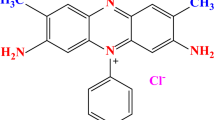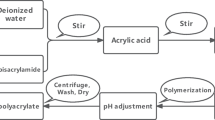Abstract
Sorption equilibrium of phenol and aniline onto the granular activated carbon and hyperreticulated un-functionalized polymeric resin (MN200) was investigated in single and binary component aqueous systems. Higher loading was obtained for aniline than phenol onto both sorbents, which is probably due to hydrophobic difference between both solutes and the greater electronic density of the aromatic ring of the aniline. Granular activated carbon reported larger uptake than resin MN200 for both solutes, which may be attributed to the better physical properties of the granular activated carbon, for instance, larger surface area. The experimental sorption could be properly described by the Langmuir and Freundlich isotherms. Five models for predicting the binary equilibrium sorption isotherm were compared in order to determine the best fit model to correlate binary experimental data: the extended Langmuir isotherm with and without a constant interaction factor, a simplified model based on the single equilibrium factors, the empirical extended Freundlich isotherm and the modified extended Langmuir equation, which considers the synergistic interactions between sorbate–sorbate and not only the competition between them defined by the extended Langmuir model. The modified extended Langmuir model provides the best agreement between predicted and experimental data indicating that the synergistic interactions between solutes play an important role in the binary phenol/aniline sorption system.






Similar content being viewed by others
References
Abburi, K. (2003). Adsorption of phenol and p-chlorophenol from their single and bisolute aqueous solutions on Amberlite XAD-16 resin. Journal of Hazardous Materials, 105, 143–156.
Ahmaruzzaman, M. (2008). Adsorption of phenolic compounds on low-cost adsorbents: a review. Advanced Colloid and Interface Science, 143, 48–67.
Ahmaruzzaman, M., & Sharma, D. K. (2005). Adsorption of phenols from wastewater. Journal of Colloid and Interface Science, 287, 14–24.
Burghoff, B., Goetheer, E. L. V., & de Haan, A. B. (2008). Solvent impregnated resins for the removal of low concentration phenol from water. Reactive & Functional Polymers, 68, 1314–1324.
Busca, G., Berardinelli, S., Resini, C., & Arrighi, L. (2008). Technologies for the removal of phenol from fluid streams: a short review of recent developments. Journal of Hazardous Materials, 160, 265–288.
Chairat, M., Rattanaphani, S., Bremner, J. B., & Rattanaphani, V. (2005). An adsorption and kinetic study of lac dyeing on silk. Dyes and Pigments, 64, 231–241.
Chiou, M. S., Ho, P. Y., & Li, H. Y. (2004). Adsorption of anionic dyes in acid solutions using chemically cross-linked chitosan beads. Dyes and Pigments, 60, 69–84.
Choy, K. K. H., Porter, J. F., & McKay, G. (2000). Langmuir isotherm models applied to the multicomponent sorption of acid dyes from effluent onto activated carbon. Journal of Chemical & Engineering Data, 45, 575–584.
Figueiredo, J. L., Pereira, M. F. R., Freitas, M. M. A., & Orfao, J. J. M. (1999). Modification of the surface chemistry of activated carbons. Carbon, 37, 1379–1389.
Ko, C. H., Fan, C., Chiang, P. N., Wang, M. K., & Lin, K. C. (2007). p-Nitrophenol, phenol and aniline sorption by organo-clays. Journal of Hazardous Materials, 149, 275–282.
Ku, Y., & Lee, K. C. (2000). Removal of phenol from aqueous solutions by XAD-4 resin. Journal of Hazardous Materials, 80, 59–68.
Kujawski, W., Warszawski, A., Ratajczak, W., Porebski, T., Capała, W., & Ostrowska, I. (2004). Application of pervaporation and adsorption to the phenol removal from wastewater. Separation and Purification Technology, 40, 123–132.
László, K. (2005). Adsorption from aqueous phenol and aniline solutions on activated carbons with different surface chemistry. Colloids and Surfaces A: Physicochemical and Engineering Aspects, 265, 32–39.
Lin, S.-H., & Juang, R.-S. (2009). Adsorption of phenol and its derivatives from water using synthetic resins and low-cost natural adsorbents: a review. Journal of Environmental Management, 90, 1336–1349.
McKay, G., & Al-Duri, B. (1987). Simplified model for the equilibrium adsorption of dyes from mixtures using activated carbon. Chemical Engineering Process, 22, 145–156.
McKay, G., & Al-Duri, B. (1989). Prediction of multicomponent adsorption equilibrium data using empirical correlations. The Chemical Engineering Journal, 41, 9–23.
Ming, Z. W., Long, C. J., Cai, P. B., Xing, Z. Q., & Zhang, B. (2006). Synergistic adsorption of phenol from aqueous solution onto polymeric adsorbents. Journal of Hazardous Materials, 128, 123–129.
Nevskaia, D. M., Castillejos-Lopez, E., Guerrero-Ruiz, A., & Muñoz, V. (2007). Effects of the surface chemistry of carbon materials on the adsorption of phenol–aniline mixtures from water. Carbon, 42, 653–665.
Newalkar, B. L., & Komarneni, S. (2000). Synthesis and characterization of microporous silica prepared with sodium silicate and organosilane compounds. Journal of Sol-Gel Science and Technology, 18, 191–198.
Oh, C.-G., Ahn, J.-H., & Ihm, S.-K. (2003). Adsorptive removal of phenolic compounds by using hypercrosslinked polystyrenic beads with bimodal pore size distribution. Reactive & Functional Polymers, 57, 103–111.
Streat, M., & Sweetland, L. A. (1997). Physical and adsorptive properties of Hypersol-Macronet polymers. Reactive & Functional Polymers, 35, 99–109.
Tessmer, C. H., Vidic, R. D., & Uranowski, L. J. (1997). Impact of oxygen-containing surface functional groups on activated carbon adsorption of phenols. Environmental Science & Technology, 31, 1872–1878.
Valderrama, C., Cortina, J. L., Farran, A., Marti, V., Gamisans, X., & de las Heras, F. X. (2008). Characterization of azo dye (acid red 14) removal with granular activated carbon: equilibrium and kinetic data. Solvent Extraction and Ion Exchange, 26, 271–288.
Valderrama, C., Cortina, J. L., Farran, A., Gamisans, X., & de las Heras, F. X. (2008). Evaluation of hyper-cross-linked polymeric sorbents (Macronet MN200 and MN300) on dye (acid red 14) removal process. Reactive & Functional Polymers, 68, 679–691.
Vazquez, I., Rodriguez-Iglesias, J., Marañón, E., Castrillón, L., & Álvarez, M. (2007). Removal of residual phenols from coke wastewater by adsorption. Journal of Hazardous Materials, 147, 395–400.
Wagner, K., & Schulz, S. (2001). Adsorption of phenol, chlorophenols, and dihydroxybenzenes onto unfunctionalized polymeric resins at temperatures from 294.15 K to 318.15 K. Journal of Chemical & Engineering Data, 46, 322–330.
Xu, M.-C., Zhoua, Y., & Huang, J.-H. (2008). Adsorption behaviours of three polymeric adsorbents with amide groups for phenol in aqueous solution. Journal of Colloid and Interface Science, 327, 9–14.
Yang, K., Wu, W., Jing, Q., & Zhu, L. (2008). Aqueous adsorption of aniline, phenol, and their substitutes by multi-walled carbon nanotubes. Environmental Science and Technology, 42, 7931–7936.
Yesuf, J. N., DeVantier, B. A., & Chevalier, L. R. (2008). Bisolute equilibrium studies for the sorption of basic dyes on a GAC from almond shells: a nonlinear approach. Water, Air, & Soil Pollution: Focus, 8, 387–393.
Zhang, W., Chen, J., Pan, B., Chen, Q., He, M., Zhang, Q., et al. (2006). Synergistic effect on phenol/aniline mixture adsorption on nonpolar resin adsorbents from aqueous solution. Reactive & Functional Polymers, 66, 395–401.
Zhang, W. M., Zhang, Q. J., Pan, B. C., Lv, L., Pan, B. J., Xu, Z. W., et al. (2007). Modelling synergistic adsorption of phenol/aniline mixtures in the aqueous phase onto porous polymer adsorbents. Journal of Colloid and Interface Science, 306, 216–221.
Zhang, W., Xu, Z., Pan, B., Zhang, Q., Du, W., Zhang, Q., et al. (2007). Adsorption enhancement of laterally interacting phenol/aniline mixtures onto nonpolar adsorbents. Chemosphere, 66, 2044–2049.
Acknowledgments
We wish to acknowledge the contribution of MEC project CTQ2008-06842-C02/01PPQ (Spanish Ministry of Education and Science). We would also like to thank Purolite Ltd. for the MN200 samples and Aguas de Levante for the granular activated carbon samples.
Author information
Authors and Affiliations
Corresponding author
Rights and permissions
About this article
Cite this article
Valderrama, C., Barios, J.I., Farran, A. et al. Evaluating Binary Sorption of Phenol/Aniline fromAqueous Solutions onto Granular Activated Carbon and Hypercrosslinked Polymeric Resin (MN200). Water Air Soil Pollut 210, 421–434 (2010). https://doi.org/10.1007/s11270-009-0266-7
Received:
Accepted:
Published:
Issue Date:
DOI: https://doi.org/10.1007/s11270-009-0266-7




